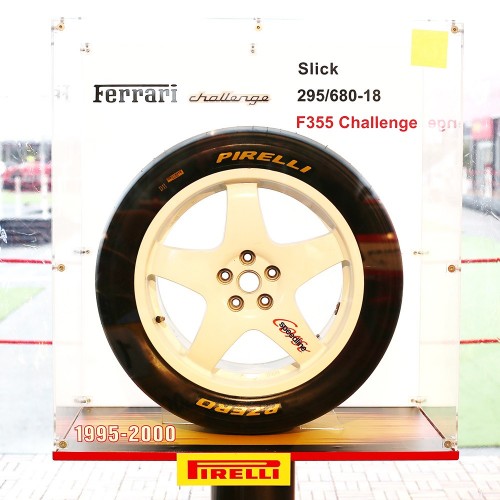www.magazine-industry-usa.com
07
'18
Written on Modified on
Pirelli showcases the technical evolution of ferrari gt tyres at the ferrari finali mondiali this weekend
All the tyres ever created for the ferrari challenge displayed at monza, during the most important sporting event of the year for the prancing horse.

This is territory that Pirelli knows well, having been the exclusive tyre supplier to the Ferrari Challenge ever since the championship made its debut. This presented an important opportunity for Pirelli to study new concepts in extreme conditions – as is always the case in motorsport, among eager gentlemen drivers – but based on road-going cars, with the same characteristics and dynamics. The Ferrari Challenge was born in 1993 and since then more than 1000 drivers have taken part.
The number of tyres used has been simply incalculable. Also because, following on from the European series, the Ferrari Challenge has also expanded to Asia and the United States: a whole world of gentlemen drivers, each at the wheel of a Ferrari equipped with Pirelli tyres.
Cars and tyres: the history of the Ferrari challenge
The very first car that got the one-make series underway was the Ferrari 348 Challenge. It was derived from the 1989 348 TB and TS, carrying over the road car’s 3.5-litre V8 engine that put out 320 horsepower.
Compared to the road-going version, the 348 Challenge car wasn’t extensively modified, but it did wear slick tyres that were especially developed by Pirelli. The very first Ferrari Challenge tyre was a 17-inch slick with different sizes at front and rear (245/620-17 and 265/640-17 respectively).
Just like the car, the tyres also had a strong link with their road-going equivalents: to make them, Pirelli used the normal P Zero moulds, but with a specific construction and compounds.
The 348 drove its last races in 1996, alongside the new 355 Challenge car. This too was a direct descendant of its road-going equivalent, including the 380-horsepower engine that was identical to the road car. The safety devices needed for competition and bespoke Pirelli tyres made it different though. The Italian firm made its first 18-inch tyres for Ferrari’s one-make series: a size that would remain for more than 10 years.
In 2000, the third car to be used on the Ferrari Challenge made its debut: the 360 Challenge, which was based on the 360 Modena. It had the same power as the road car (400 horsepower) but less weight.
The 360 Challenge car underwent some important modifications the following year, with power rising to 415 horsepower. More performance was being asked of the tyres as well, but the generation of Pirelli tyres that was born with the 355 was still more than capable of responding to the demands of cars and drivers, which meant that only new sizes and compounds were introduced.
The 430 Challenge marked an important new step for the one-make series: while it put out the same 490 horsepower of the road car, it was adapted thanks also to the lessons that Ferrari had learned in Formula 1. For example, it boasted the first carbon ceramic braking system of any Ferrari competition car, so the tyres also needed some important modifications. The first 19-inch tyres were made, both as slicks and wets, but these became ‘full wet’ tyres for the first time, with a specific full wet tread pattern.
In 2010, the acclaimed Ferrari 458 Italia formed the base of the latest Challenge car, taking to the track with the same 570 horsepower as the road car but weighing 100 kilograms lighter and with specific engine mapping and a competition exhaust. There was also an electronic rear differential that required the tyres to work in parallel with it. Pirelli adapted the tyre dimensions and compound, while maintaining the same wheel size.
Turbocharging came to the Ferrari Challenge in 2016 with the arrival of the 488 Challenge: the first time that a turbo engine had ever been seen on the championship in 25 years of history. There was a 100-horsepower increase compared to the 458, while the lap time round Fiorano came down by a second. Pirelli developed new tyre sizes for the 488 Challenge to cope with the car’s extra performance.
Theo Mayer, who manages Pirelli’s Ferrari Challenge programme, said: “It’s an excellent opportunity for Pirelli to work alongside Ferrari on the Challenge. Alongside the professional drivers there are also gentlemen drivers: amateurs who have other real world commitments on top of racing.The tyres are always developed in parallel with the car, one year before the Challenge is officially launched, enhancing drivability and performance for drivers at every level. The objective of these developments has been to maximise performance, using the latest technical innovations from Pirelli’s renowned motorsport department.This helps to make the tyres more driveable in all dry conditions, For rainy conditions, a specific full wet tyre has been developed. Now that we are entering the 26th year of our partnership, our next objective will be to celebrate half a century together.”
www.pirelli.com

